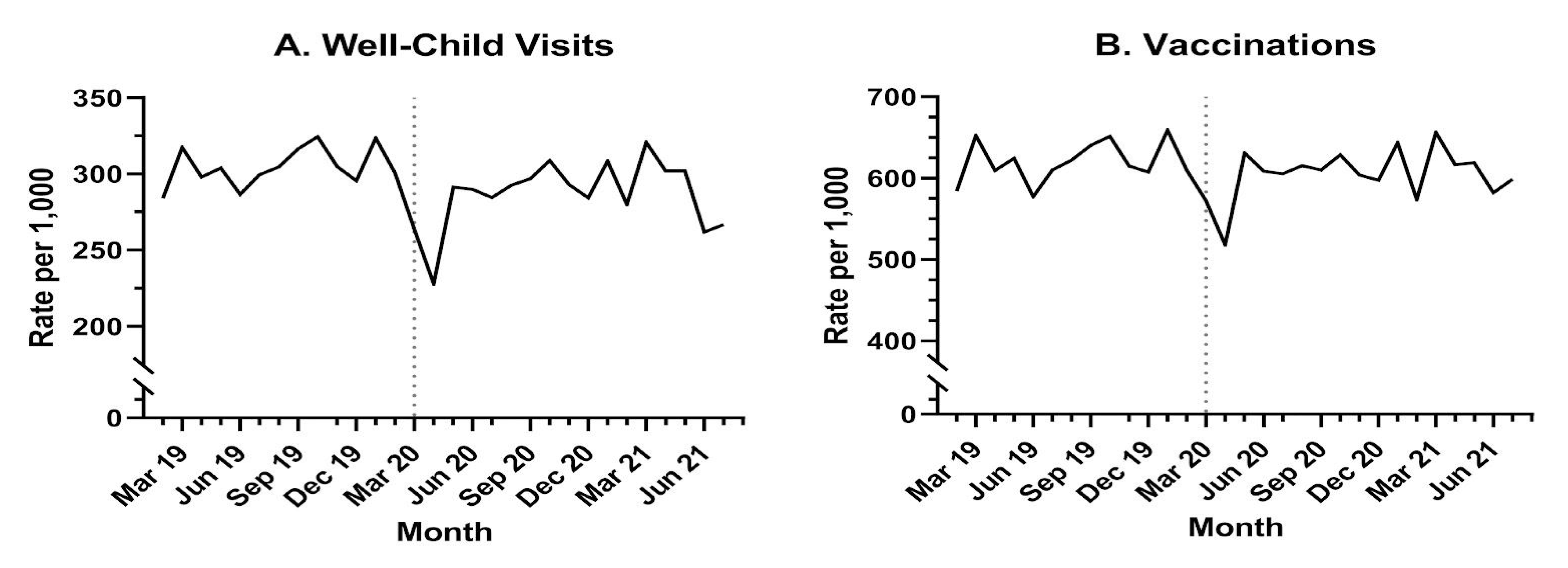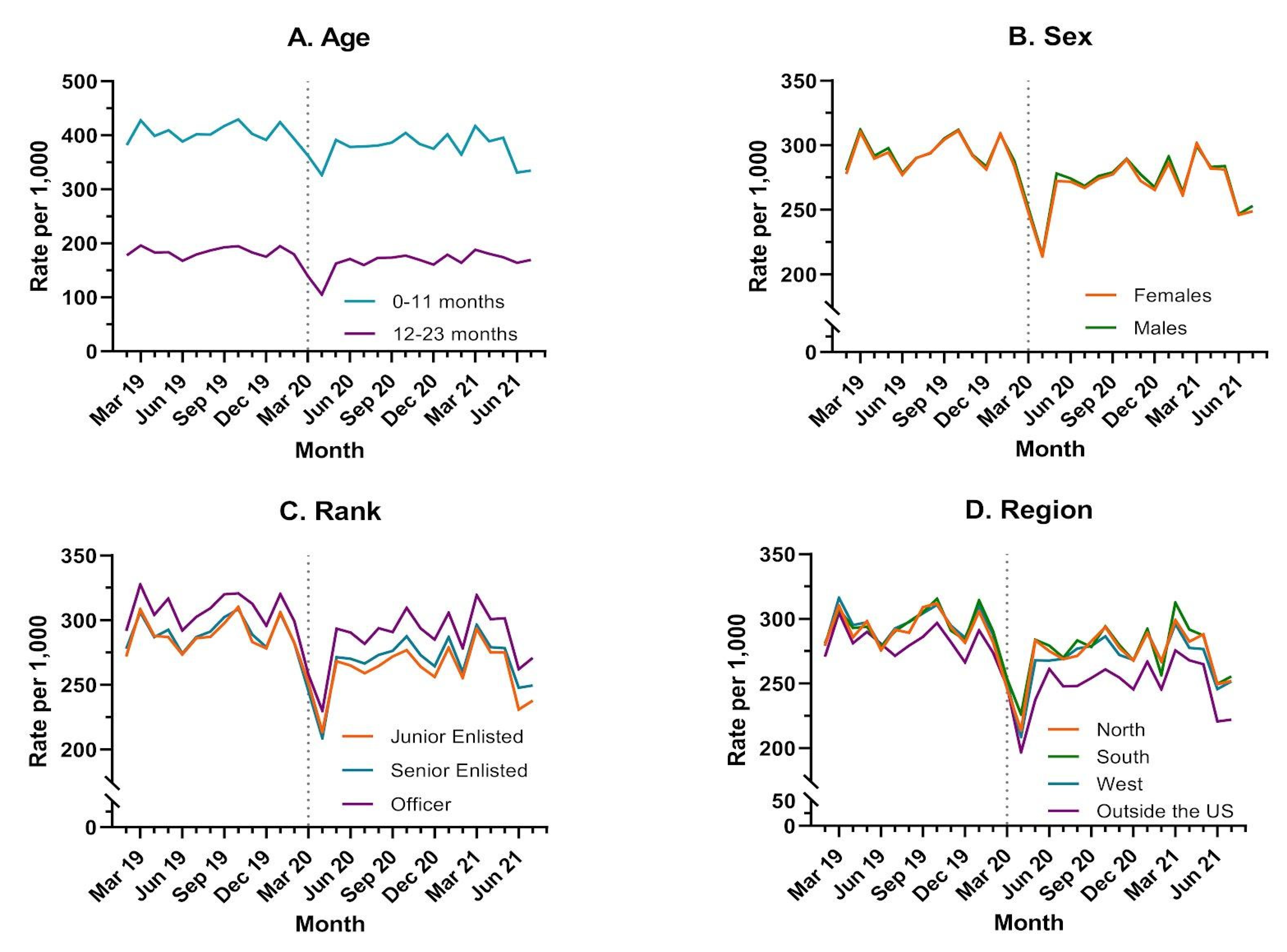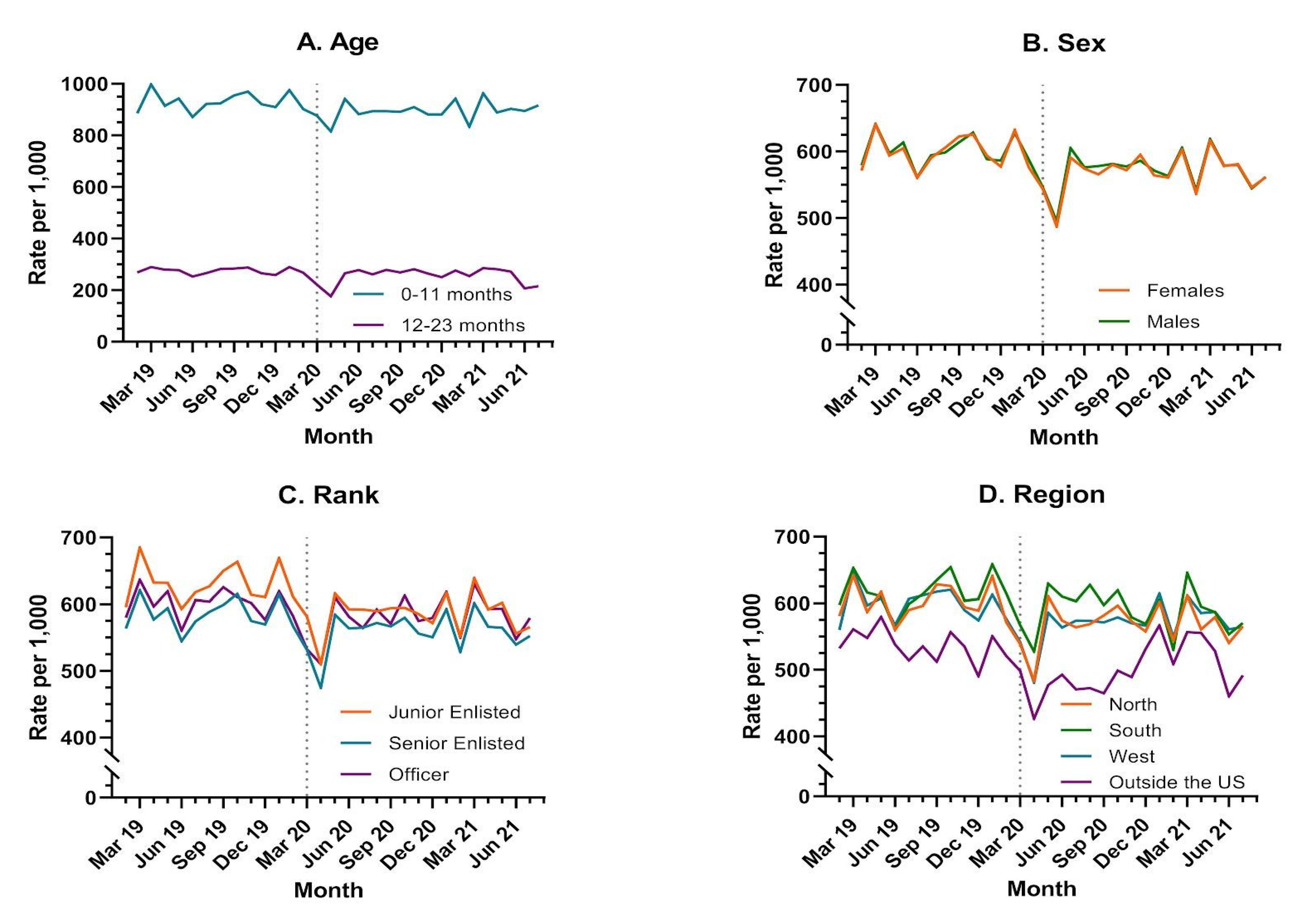Trends in Well-Child Visits and Routine Vaccination among Children of U.S. Military Members: An Evaluation of the COVID-19 Pandemic Effects
Abstract
1. Introduction
2. Materials and Methods
3. Results
3.1. Well-Child Visits in the Pre-COVID-19 and COVID-19 Time Periods
3.2. Vaccination in the Pre-COVID-19 and COVID-19 Time Periods
4. Discussion
5. Conclusions
Supplementary Materials
Author Contributions
Funding
Institutional Review Board Statement
Informed Consent Statement
Data Availability Statement
Conflicts of Interest
Disclaimer
References
- Brown, C.L.; Montez, K.; Amati, J.B.; Simeonsson, K.; Townsend, J.D.; Orr, C.J.; Palakshappa, D. Impact of COVID-19 on Pediatric Primary Care Visits at Four Academic Institutions in the Carolinas. Int. J. Environ. Res. Public Health 2021, 18, 5734. [Google Scholar] [CrossRef] [PubMed]
- Anderson, K.E.; McGinty, E.E.; Presskreischer, R.; Barry, C.L. Reports of Forgone Medical Care Among US Adults During the Initial Phase of the COVID-19 Pandemic. JAMA Netw Open 2021, 4, e2034882. [Google Scholar] [CrossRef] [PubMed]
- Tom, J.O.; Tseng, C.W.; Davis, J.; Solomon, C.; Zhou, C.; Mangione-Smith, R. Missed well-child care visits, low continuity of care, and risk of ambulatory care-sensitive hospitalizations in young children. Arch. Pediatr. Adolesc. Med. 2010, 164, 1052–1058. [Google Scholar] [CrossRef] [PubMed]
- Salas, J.; Hinyard, L.; Cappellari, A.; Sniffen, K.; Jacobs, C.; Karius, N.; Grucza, R.A.; Scherrer, J.F. Infant, pediatric and adult well visit trends before and during the COVID-19 pandemic: A retrospective cohort study. BMC Health Serv Res. 2022, 22, 328. [Google Scholar] [CrossRef] [PubMed]
- Kujawski, S.A.; Yao, L.; Wang, H.E.; Carias, C.; Chen, Y.T. Impact of the COVID-19 pandemic on pediatric and adolescent vaccinations and well child visits in the United States: A database analysis. Vaccine 2022, 40, 706–713. [Google Scholar] [CrossRef] [PubMed]
- Turner, K. Well-Child Visits for Infants and Young Children. American Family Physician, 15 September 2018. Available online: https://www.aafp.org/afp/2018/0915/p347.html#commenting (accessed on 18 November 2022).
- Callison, K.; Ward, J. Associations between Individual Demographic Characteristics and Involuntary Health Care Delays as a Result Of COVID-19. Health Af (Millwood) 2021, 40, 837–843. [Google Scholar] [CrossRef] [PubMed]
- Committee on Pediatric Workforce. Scope of practice issues in the delivery of pediatric health care. Pediatrics 2013, 131, 1211–1216. [Google Scholar] [CrossRef] [PubMed]
- Hammon, L.; Mondzelewski, L.; Robinson, C.; Milder, E. Well-Child Care Disparities in U.S. Military Health System. Acad. Pediatr. 2022. [Google Scholar] [CrossRef] [PubMed]
- Selden, T.M. Compliance with Well-Child Visit Recommendations: Evidence from the Medical Expenditure Panel Survey, 2000–2002. Pediatrics 2006, 118, e1766–e1778. [Google Scholar] [CrossRef] [PubMed]
- Van Berckelaer, A.C.; Mitra, N.; Pati, S. Predictors of well child care adherence over time in a cohort of urban Medicaid-eligible infants. BMC Pediatr. 2011, 11, 36. [Google Scholar] [CrossRef] [PubMed]
- Yao, J.; Perzynski, A.T.; Tarabichi, Y.; Swarup, N.; Roy, A. Socioeconomic Distress as a Predictor of Missed First Outpatient Newborn Visits. Cureus 2021, 13, e14132. [Google Scholar] [CrossRef] [PubMed]
- DeGuzman, P.B.; Huang, G.; Lyons, G.; Snitzer, J.; Keim-Malpass, J. Rural Disparities in Early Childhood Well Child Visit Attendance. J. Pediatr. Nurs. 2021, 58, 76–81. [Google Scholar] [CrossRef] [PubMed]
- Defense Finance Accounting Service (DFAS). Pay Tables. 1 January 2022. Available online: https://www.dfas.mil/militarymembers/payentitlements/Pay-Tables/ (accessed on 18 November 2022).
- 2020 Demographics Profile of the Military Community. Available online: https://download.militaryonesource.mil/12038/MOS/Reports/2020-demographics-report.pdf (accessed on 18 November 2022).
- Home Visiting for Military Families: An Overview of Innovative Programs—NHVRC. Innovation Roundup; National Home Visiting Resource Center, March 2019. Available online: https://www.nhvrc.org/wp-content/uploads/NHVRC-Brief-031819-FINAL.pdf (accessed on 18 November 2022).
- Uscher-Pines, L.; McCullough, C.; Dworsky, M.S.; Sousa, J.; Predmore, Z.; Ray, K.; Magit, A.; Rivanis, C.; Lerner, C.; Iwakoshi, J.; et al. Use of Telehealth Across Pediatric Subspecialties Before and During the COVID-19 Pandemic. JAMA Netw. Open 2022, 5, e224759. [Google Scholar] [CrossRef] [PubMed]
- Centers for Medicare & Medicaid Services. COVID-19 Emergency Declaration: Blanket Waivers for Health Care Providers. 25 June 2020. Available online: https://www.cms.gov/files/document/summary-covid-19-emergency-declaration-waivers.pdf (accessed on 28 July 2022).
- Alexander, G.C.; Tajanlangit, M.; Heyward, J.; Mansour, O.; Qato, D.M.; Stafford, R.S. Use and Content of Primary Care Office-Based vs Telemedicine Care Visits During the COVID-19 Pandemic in the US. JAMA Netw. Open. 2020, 3, e2021476. [Google Scholar] [CrossRef] [PubMed]
- Dinleyici, E.C.; Borrow, R.; Safadi, M.A.P.; van Damme, P.; Munoz, F.M. Vaccines and routine immunization strategies during the COVID-19 pandemic. Hum. Vaccines Immunother. 2021, 17, 400–407. [Google Scholar] [CrossRef] [PubMed]
- Administration for Strategic Preparedness and Response (ASPR). Public Readiness and Emergency Preparedness (PREP) Act. Available online: https://aspr.hhs.gov/legal/PREPact/Pages/default.aspx (accessed on 18 November 2022).



| Full Study Period Median (IQR) | Pre-COVID-19 Median (IQR) | COVID-19 Period Median (IQR) | p-Value | |
|---|---|---|---|---|
| Age in months | ||||
| 0–11 months | 49.36 (49.16–49.70) | 49.73 (49.69–49.77) | 49.18 (49.15–49.25) | <0.0001 |
| 12–23 months | 50.64 (50.30–50.84) | 50.27 (50.23–50.31) | 50.82 (50.75–50.85) | <0.0001 |
| Parent’s military rank | ||||
| Junior Enlisted | 26.59 (26.52–26.76) | 26.68 (26.53–26.76) | 26.59 (26.44–26.74) | 0.4513 |
| Senior Enlisted | 52.72 (52.58–52.84) | 52.78 (52.66–52.85) | 52.67 (52.53–52.80) | 0.1672 |
| Officer | 20.68 (20.60–20.75) | 20.59 (20.55–20.62) | 20.73 (20.69–20.82) | <0.0001 |
| Sex | ||||
| Female | 48.82 (48.76–48.87) | 48.67 (48.86–48.88) | 48.77 (48.70–48.83) | 0.0011 |
| Male | 51.18 (51.13–51.24) | 51.13 (51.12–51.14) | 51.23 (51.17–51.30) | 0.0011 |
| Region | ||||
| North | 30.58 (30.54–30.69) | 30.70 (30.61–30.74) | 30.55 (30.52–30.58) | 0.0003 |
| South | 29.38 (29.19–29.49) | 29.19 (29.17–29.22) | 29.48 (29.42–29.53) | <0.0001 |
| West | 32.94 (32.83–33.03) | 32.83 (32.79–32.87) | 33.00 (32.92–33.10) | 0.0003 |
| Outside the continental U.S. | 7.18 (6.94–7.27) | 7.28 (7.27–7.31) | 6.96 (6.85–7.10) | <0.0001 |
| Well-Child Visit Rate per 1000 Children <24 Months | Vaccination Rate per 1000 Children <24 Months | |||||||
|---|---|---|---|---|---|---|---|---|
| Full Study Median (IQR) | Pre-COVID-19 Median (IQR) | COVID-19 Median (IQR) | p-Value | Full Study Median (IQR) | Pre-COVID-19 Median (IQR) | COVID-19 Median (IQR) | p-Value | |
| Overall Population | ||||||||
| All | 282 (273–292) | 291 (282–305) | 275 (264–283) | <0.0001 | 581 (568–602) | 594 (582–618) | 575 (562–586) | <0.0001 |
| Age in months | ||||||||
| 0–11 | 391 (379–403) | 402 (394–417) | 381 (364–391) | 0.0013 | 906 (885–941) | 922 (910–954) | 894 (882–909) | 0.0135 |
| 12–23 | 176 (168–183) | 183 (179–193) | 169 (163–174) | 0.0004 | 268 (259–281) | 278 (266–284) | 265 (251–278) | 0.0542 |
| Parent Rank | ||||||||
| Junior Enlisted | 275 (264–287) | 287 (283–298) | 264 (255–275) | 0.0001 | 599 (590–627) | 627 (611–650) | 592 (572–595) | 0.0003 |
| Senior Enlisted | 279 (270–289) | 289 (282–302) | 271 (260–279) | 0.0004 | 569 (556–589) | 577 (570–599) | 565 (550–572) | 0.0107 |
| Officer | 298 (291–310) | 309 (299–320) | 291 (278–301) | 0.0020 | 592 (575–610) | 604 (582–619) | 580 (565–593) | 0.0364 |
| Sex | ||||||||
| Females | 281 (272–292) | 292 (284–304) | 272 (261–281) | 0.0003 | 579 (564–603) | 594 (577–622) | 572 (561–581) | 0.0095 |
| Males | 283 (274–293) | 293 (288–305) | 276 (264–283) | 0.0003 | 584 (571–546) | 597 (588–614) | 578 (562–581) | 0.0039 |
| Region | ||||||||
| North | 283 (271–294) | 292 (282–306) | 275 (267–283) | 0.0034 | 581 (563–601) | 594 (587–626) | 569 (558–582) | 0.0065 |
| South | 286 (278–294) | 293 (290–305) | 279 (257–287) | 0.0044 | 604 (579–619) | 614 (604–635) | 595 (569–610) | 0.0265 |
| West | 279 (268–295) | 295 (288–304) | 269 (267–278) | <0.0001 | 578 (566–608) | 606 (576–613) | 571 (563–585) | 0.0074 |
| Outside the continental U.S. | 267 (248–281) | 281 (274–290) | 248 (245–261) | <0.0001 | 517 (490–548) | 535 (521–550) | 493 (472–528) | 0.0065 |
| Unadjusted RR (95% CI) | Pre-COVID-19 Period Adjusted RR (95% CI) | COVID-19 Period Adjusted RR (95% CI) | |
|---|---|---|---|
| Age 12–23 months vs. 0–11 months * | 0.45 (0.44–0.45) | 0.45 (0.45–0.45) | 0.44 (0.44–0.44) |
| Rank Officer vs. Junior Enlisted * | 1.08 (1.08–1.09) | 1.11 (1.10–1.11) | 1.14 (1.13–1.14) |
| Rank Senior Enlisted vs. Junior Enlisted * | 1.01 (1.01–1.02) | 1.05 (1.05–1.06) | 1.07 (1.06–1.08) |
| Sex Female vs. Male | 0.99 (0.99–0.996) | 0.99 (0.99–0.997) | 0.99 (0.99–0.997) |
| Region North vs. West * | 1.00 (0.999–1.01) | 1.00 (0.99–1.001) | 1.02 (1.02–1.03) |
| Region Outside Continental U.S. vs. West * | 0.94 (0.94–0.95) | 0.95 (0.94–0.96) | 0.92 (0.91–0.92) |
| Region South vs. West * | 1.01 (1.01–1.02) | 1.01 (1.004–1.02) | 1.04 (1.03–1.04) |
| Time Period COVID-19 vs. Pre-COVID-19 | 0.93 (0.93–0.93) | — | — |
| Age | Rank | Region | |||
|---|---|---|---|---|---|
| North | South | West | Outside the Continental U.S. | ||
| 0–11 months | Junior Enlisted | 0.93 (0.92–0.94) | 0.93 (0.92–0.95) | 0.93 (0.91–0.94) | 0.89 (0.87–0.92) |
| Senior Enlisted | 0.95 (0.94–0.95) | 0.95 (0.94–0.96) | 0.93 (0.92–0.94) | 0.91 (0.89–0.92) | |
| Officer | 0.96 (0.95–0.97) | 0.95 (0.94–0.96) | 0.95 (0.93–0.96) | 0.92 (0.90–0.95) | |
| 12–23 months | Junior Enlisted | 0.92 (0.90–0.93) | 0.94 (0.92–0.95) | 0.87 (0.85–0.89) | 0.85 (0.81–0.89) |
| Senior Enlisted | 0.94 (0.93–0.96) | 0.94 (0.93–0.95) | 0.90 (0.89–0.91) | 0.84 (0.82–0.86) | |
| Officer | 0.96 (0.95–0.98) | 0.96 (0.94–0.98) | 0.91 (0.89–0.92) | 0.86 (0.82–0.89) | |
| Unadjusted RR (95% CI) | Pre-COVID-19 Period Adjusted RR (95% CI) | COVID-19 Period Adjusted RR (95% CI) | |
|---|---|---|---|
| Age 12–23 months vs. 0–11 months * | 0.29 (0.29–0.29) | 0.29 (0.29–0.29) | 0.29 (0.29–0.29) |
| Rank Officer vs. Junior Enlisted * | 0.97 (0.97–0.98) | 1.005 (1.001–1.009) | 1.04 (1.04–1.05) |
| Rank Senior Enlisted vs. Junior Enlisted * | 0.94 (0.94–0.94) | 0.99 (0.99–0.997) | 1.02 (1.01–1.02) |
| Sex Female vs. Male | 0.996 (0.994–0.998) | 0.995 (0.992–0.998) | 0.996 (0.994–0.999) |
| Region North vs. West | 1.00 (0.998–1.003) | 1.02 (1.01–1.02) | 1.01 (1.01–1.02) |
| Region Outside the Continental U.S. vs. West * | 0.89 (0.88–0.89) | 0.89 (0.89–0.90) | 0.87 (0.86–0.87) |
| Region South vs. West | 1.03 (1.03–1.04) | 1.05 (1.04–1.05) | 1.05 (1.05–1.06) |
| Time Period COVID-19 vs. Pre-COVID-19 | 0.96 (0.96–0.96) | — | — |
| Age | Rank | Region | |||
|---|---|---|---|---|---|
| North | South | West | Outside the Continental U.S. | ||
| 0–11 months | Junior Enlisted | 0.95 (0.95–0.96) | 0.96 (0.95–0.96) | 0.95 (0.95–0.96) | 0.91 (0.89–0.93) |
| Senior Enlisted | 0.96 (0.96–0.97) | 0.98 (0.98–0.99) | 0.97 (0.96–0.97) | 0.95 (0.94–0.97) | |
| Officer | 0.98 (0.97–0.99) | 0.98 (0.97–0.99) | 0.99 (0.98–0.999) | 0.95 (0.94–0.97) | |
| 12–23 months | Junior Enlisted | 0.93 (0.92–0.95) | 0.91 (0.89–0.92) | 0.92 (0.91–0.94) | 0.88 (0.85–0.92) |
| Senior Enlisted | 0.95 (0.94–0.96) | 0.96 (0.95–0.97) | 0.96 (0.95–0.97) | 0.92 (0.90–0.94) | |
| Officer | 0.98 (0.96–0.99) | 0.97 (0.95–0.98) | 0.96 (0.95–0.98) | 0.95 (0.91–0.99) | |
Publisher’s Note: MDPI stays neutral with regard to jurisdictional claims in published maps and institutional affiliations. |
© 2022 by the authors. Licensee MDPI, Basel, Switzerland. This article is an open access article distributed under the terms and conditions of the Creative Commons Attribution (CC BY) license (https://creativecommons.org/licenses/by/4.0/).
Share and Cite
Sexton, K.; Susi, A.; Lee, E.; Hisle-Gorman, E.; Rajnik, M.; Krishnamurthy, J.; Nylund, C.M. Trends in Well-Child Visits and Routine Vaccination among Children of U.S. Military Members: An Evaluation of the COVID-19 Pandemic Effects. J. Clin. Med. 2022, 11, 6842. https://doi.org/10.3390/jcm11226842
Sexton K, Susi A, Lee E, Hisle-Gorman E, Rajnik M, Krishnamurthy J, Nylund CM. Trends in Well-Child Visits and Routine Vaccination among Children of U.S. Military Members: An Evaluation of the COVID-19 Pandemic Effects. Journal of Clinical Medicine. 2022; 11(22):6842. https://doi.org/10.3390/jcm11226842
Chicago/Turabian StyleSexton, Kyle, Apryl Susi, Elizabeth Lee, Elizabeth Hisle-Gorman, Michael Rajnik, Jayasree Krishnamurthy, and Cade M. Nylund. 2022. "Trends in Well-Child Visits and Routine Vaccination among Children of U.S. Military Members: An Evaluation of the COVID-19 Pandemic Effects" Journal of Clinical Medicine 11, no. 22: 6842. https://doi.org/10.3390/jcm11226842
APA StyleSexton, K., Susi, A., Lee, E., Hisle-Gorman, E., Rajnik, M., Krishnamurthy, J., & Nylund, C. M. (2022). Trends in Well-Child Visits and Routine Vaccination among Children of U.S. Military Members: An Evaluation of the COVID-19 Pandemic Effects. Journal of Clinical Medicine, 11(22), 6842. https://doi.org/10.3390/jcm11226842







